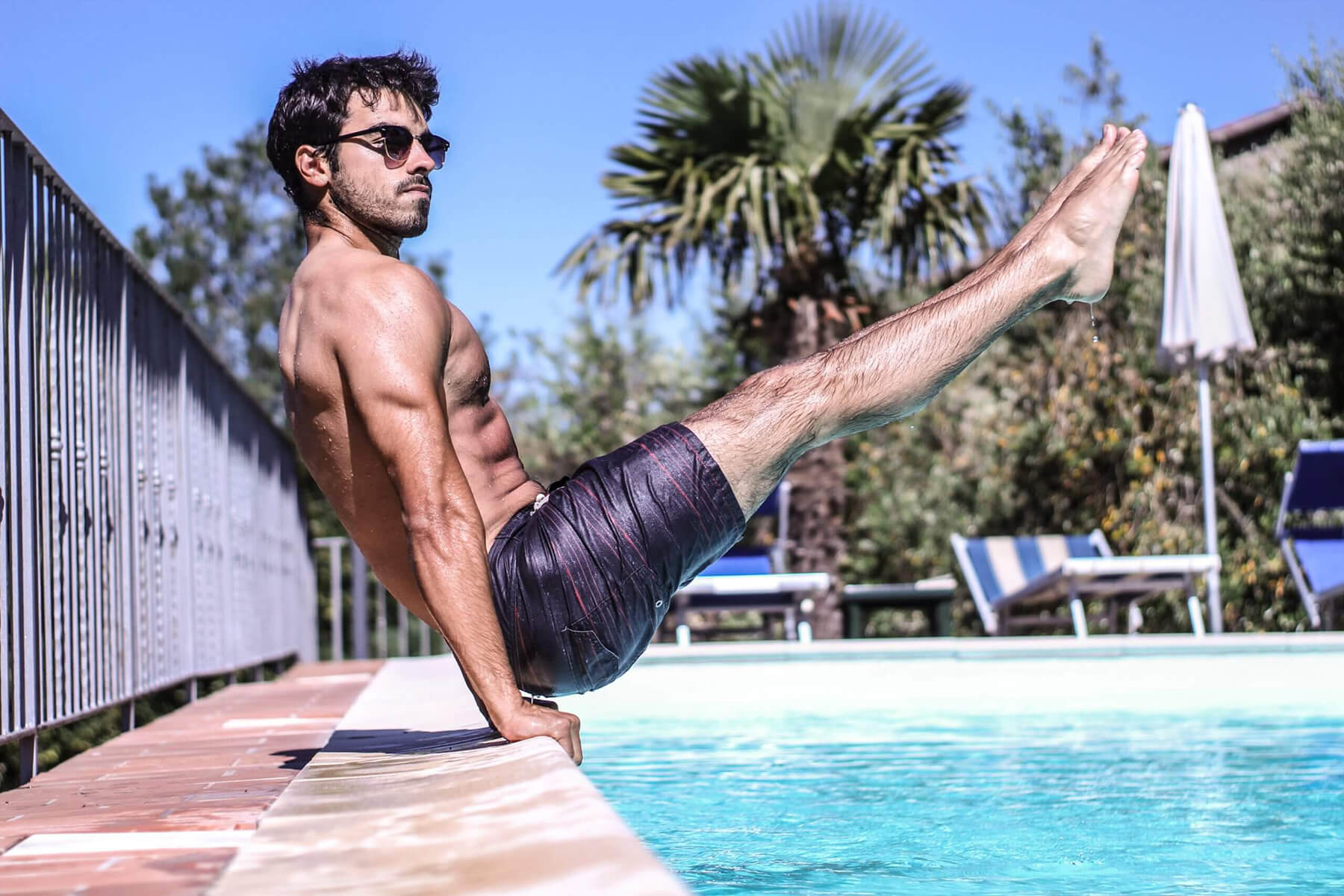In 2016, the total count of people who do calisthenics exercises rose to over 25 million in the US. To this day, many people are still learning calisthenics to reap its benefits, which include burning and insane amount of calories due to the involvement of the movements.
Since calisthenics training hardly requires any equipment at all, it’s a popular exercise strategy among those who don’t want to spend lots of money on expensive gym equipment.
Read on to learn more about this powerful exercise routine and its amazing effects.
Calisthenics Exercises – What Are They and How Do They Benefit You?
Calisthenics (also referred to as bodyweight) is a type of physical exercise that uses only the body’s weight and gravity to work out. It involves exercises that use minimal or no equipment at all and instead focus on using the person’s own body weight for resistance.
This form of exercise targets multiple muscle groups in unison – the core, arms, chest, back, as well as your legs – to help develop strength and coordination while improving balance and flexibility.
Because calisthenics is anaerobic, it can be used to burn calories quickly (compared to aerobic exercises like jogging). Additionally, calisthenics exercises are considered to be effective fat burners and can help you achieve a leaner physique in no time. That’s why calisthenics is often recommended for those who want to lose weight quickly.
Starting calisthenics involves learning the basics of bodyweight exercises and mastering them with proper form. The fundamental movements are usually simple, like push-ups, squats, pull-ups, dips, and lunges – but they require lots of practice to learn correctly. Fortunately, once you have mastered the basic moves, there are many other more complex variations that will challenge your strength and coordination even further.
Calisthenics for Beginners
Those trying calisthenics for the first time should start with some basic exercises and progress gradually to more advanced moves. Push-ups, squats, planks, pull-ups, and lunges are the staple exercises of any calisthenics program for beginners. Once you have mastered these fundamental movements, you can start adding more challenging variations like modified push-ups (such as diamond push-ups), single-leg squats, and triceps dips.
To help establish a proper routine for yourself and stay motivated in your journey to becoming fit, we recommend that newbies create their own beginner calisthenics program based on their fitness goals. A typical beginner’s program consists of three full-body workouts per week, each lasting for about 30 minutes.
Calisthenics Equipment
“But wait, I thought you said ‘no equipment’?”
The truth is, while you can do calisthenics without any equipment at all, having the right tools in your home gym can help make your workouts more effective and enjoyable. Some of the best pieces of calisthenics equipment include resistance bands, parallel bars, a pull-up bar, exercise rings or sliders for planks and push-ups, and a dip station.
For those who prefer to keep their training minimalist yet still want an edge over bodyweight exercises alone, there are plenty of affordable options, such as jump ropes for cardio sessions or weighted vests for added resistance. However, if you’re just starting out, it’s best to focus on mastering the fundamentals of calisthenics first before investing in more equipment.
How to Do It Even Without Equipment
That said, even if you don’t have any gear at your disposal, there are still plenty of bodyweight exercises you can do without needing any special tools. These include air squats, planks, push-up variations, and pull-ups (if you have something sturdy enough to hang from, like a door frame). With some creativity and determination, anyone can start trying calisthenics without having to spend any money on extra equipment.
Calisthenics Workout Routines
Calisthenics workout routines are an excellent way to improve physical fitness and build strength, endurance, and mobility. The key to putting together successful calisthenics routines is understanding the basics of muscle group training and exercise sequencing.
When planning a weekly routine, it’s important to focus on the following muscle groups each day for optimal results:
Day 1: Work on the lower body in order to develop strength and power in the legs, hips, and glutes. Exercises like squats, lunges, hip thrusts, calf raises, and jump squats should be included in this day’s routine.
Day 2: Focus on upper body exercises that target the chest, shoulders, back muscles, and arms. Push-ups, pull-ups/chin-ups/pulldowns are all great options for this day of training as well as any shoulder variations such as overhead press or lateral raises.
Day 3: Work your core with a variety of movements such as planks (front & side), mountain climbers, and bicycle crunches.
Day 4: Include a mix of exercises from the previous days as well as any additional cardio exercises such as running, skipping, and jumping jacks.
Remember that these muscle groups should be worked in alternating fashion so that one muscle group is given a chance to recover before being worked again. Don’t be afraid to mix up the exercises or try new ones every week to keep things interesting. With a little creativity and experimentation, you can create an effective workout and later on transition to a full-body routine.
Full Body Calisthenics Workout
A full body calisthenics workout is an effective way to train all major muscle groups in one comprehensive routine. For this workout, begin with a warm-up, such as jogging or jumping rope for 5-10 minutes. Then move into the following exercises:
- Push-ups: 3 Sets of 10-15 Reps
- Pull-ups: 3 Sets of 8-12 Reps
- Squats: 3 Sets of 15-20 Reps
- Lunges: 3 Sets of 10-15 Reps (5-8 each leg)
- 5 Back Extensions: 2 sets of 12-16 reps
Finish your workout with a cool-down and stretch. This full body routine can be performed three times per week for optimal results. Its benefits? Increased strength, better posture, and improved overall fitness.
Is Full Body Calisthenics for Everyone?
It is always important to know your limits when it comes to exercise. Though calisthenics is generally considered safe and effective, you should always speak with a medical professional before starting any new fitness routine. Be sure to listen to your body and take breaks if you need them.
Calisthenics Back Workout
Want to build more strength and muscle in your back? Calisthenics back workouts are the way to go. Begin with a warm-up, such as jogging or jumping rope for 5-10 minutes. Then move into a series of pull-ups (3 sets, 8 reps), inverted rows (3 sets, 10 reps), push-up negatives (2 sets, 10 reps), bent-over rows (3 sets, 10 reps with either a barbell, dumbbells, or a resistance band), and bicycle crunches (2 sets, 15 reps for each side).
Be sure to finish the workout with a cool-down and stretch. This back workout can be performed three times per week for optimal results. Just be careful with your back, and don’t push yourself too hard! Let’s proceed to your chest workout.
Calisthenics Chest Workout
Add even more upper-body strength by incorporating chest calisthenics into your regime to target your pectoral muscles.
Begin with a cardio warm-up, such as jogging or jumping rope for 5 minutes. Then move into a series of push-ups (3 sets, 8 reps), decline push-ups (3 sets, 10 reps), clapping push-ups (2 sets, 10 reps), and diamond push-ups (3 sets of 12).
Finally, finish the workout with an alternating shoulder-tap plank hold for 1 minute and 30 seconds. Aside from cooling down and stretching, you can also try walking slowly after doing this routine. For the best outcomes, this should be done three times per week.
Calisthenics Arm Workout
Calisthenics arm workouts are one of the most popular forms of bodyweight training. This type of exercise is designed to strengthen and tone your arm muscles without using any extra weights or machines. Typical calisthenic arm workouts consist of exercises that target the triceps, biceps, and forearms. Here’s a list of some common muscle-specific exercises:
Triceps
- Tricep dips: 3 sets of 10-12 repetitions
- Close grip push-ups: 3 sets of 8-10 repetitions
- Triceps extension calisthenics: 2 sets of 10-12 repetitions
- Chair dips: 3 sets of 10-12 repetitions
- Diamond push-ups: 3 sets of 8-10 repetitions
Biceps
- Chin-ups or pull ups: 2 to 4 sets, depending on your level of fitness and strength (8-12 repetitions for beginners, 6-8 repetitions for more advanced)
- Inverted rows: 3 sets of 8-10 repetitions
- Hammer curls: 2 sets of 10-12 repetitions
- Bicep curls with a resistance band: 2 to 4 sets (8-12 repetitions for beginners, 6-8 reps for more advanced).
Forearm
- Reverse wrist curl: 2 sets of 10 reps on each arm
- Wrist extensions: 2 sets of 12 reps on each arm
- Wrist rotations: 2 sets of 15 reps on each arm
- Grip squeezes: 2 sets of 10-12 repetitions
Remember to do these exercises with proper form and technique to ensure safety and maximum results. A good warm-up before each session is also important for avoiding injury.
Calisthenics Shoulder Workout
A workout regimen that is supplemental to your arm exercises is a calisthenics shoulder workout, which is essential for optimal deltoid health and strength. Here are some calisthenics shoulder exercises that you can do at home or in the gym:
Overhead Presses
- Seated overhead press: 3 sets, 8-10 reps
- Handstand push-ups: 2 to 3 sets (6-8 reps for beginners, 4-6 reps for more advanced)
- Shoulder taps: 2 sets of 10-12 repetitions on each side
Lateral Raises
- Standing lateral raises with a resistance band: 2 sets, 8-10 reps
- Seated lateral raises: 3 sets of 10-12 reps
Rear Deltoid Exercises
- Reverse flies with a resistance band: 2 to 3 sets (8-12 repetitions for beginners, 6-8 for more advanced)
- Bent over rows: 2 to 3 sets, 10-15 reps each set
- Face pulls with a resistance band: 2 to 3 sets (8-10 reps for beginners, 6-8 for more advanced)
While performing these shoulder workouts could take your physique to the next level, note that it is important that you are spotted by a friend/trainer for safety and to ensure your form is correct.
Don’t forget to warm up before each session with light cardio and/or dynamic stretching. You can execute these routines twice or thrice a week to get the desired effects.
Calisthenics Legs Workout
Calisthenics leg exercises are a great way to build strength and flexibility in the legs. Here is a list of movements you can choose from to get you started:
- Squats: 2 sets of 8-12 reps
- Lunges: 2 sets of 10 reps on each side
- Step-ups: 2 sets of 12 reps on each side
- Glute bridges: 2 sets of 12-15 reps
- Calf raises: 3 sets (15 repetitions for beginners, 10 repetitions for advanced)
- Hamstring calisthenics (curls): 3 Sets (10-12 repetitions for beginners, 8-10 repetitions for more advanced)
- Donkey kicks: 2 sets of 10-12 reps on each side
- Single-leg glute bridges: 2 sets of 12 reps on each side
- Hip Thrusts: 3 sets of 15 reps
- Mountain climbers: 3 sets of 20 seconds each
Some proper leg cooldowns include stretches like hip flexor, hamstring and calf stretches. You can also lie on your back and do some quadricep and glute stretches.
Calisthenics Abs Workout
Let’s not forget those 6-packs! Ab calisthenics is great for toning and strengthening the core, on top of cardiovascular health. Here is a sample ab calisthenics workout you can try at home:
- Planks: 2 sets of 30 seconds each
- Bicycle crunches: 2 sets of 15 reps on each side
- Russian twists: 3 sets of 15-20 reps
- Leg raises: 3 sets of 10-12 reps
- Rolling side planks: 2 Sets (15-20 Seconds for Each Side)
- Toe touches: 2 Sets (10 Reps)
- Lying leg pulls: 3 Sets (10 Reps on Each Side)
Allow a period of long muscle relaxation after your workout because stretching helps reduce any soreness. You can also include some gentle ab stretches and breathing exercises to relax the core muscles after each session.
What are the Safe Recovery Periods?
When you perform all of the abovementioned workout routines, make sure to understand how long recovery periods should be. Take 1-2 minutes rest between sets and 3-4 minutes rest between exercises. Stretching is also important for flexibility and increased range of motion. Spend 5-10 minutes stretching after each workout session to cool down your muscles and reduce soreness. However, when it comes down to it, you know your body best. If you feel that 1-2 minutes of rest in between sets is too much, feel free to start-up again sooner. The most important thing is to listen to your body and make sure you are not over-doing it.
Calisthenics Gym
You might be thinking about going somewhere outside of the house, or other than the park, where calisthenics is the sole focus. A calisthenics gym is a specialized facility dedicated to the practice of bodyweight exercises. It provides the necessary equipment, such as pull-up bars, dip bars, and parallettes to help perform various movements.
Calisthenics gyms also offer classes and workshops to teach people how to do certain moves correctly and safely. Furthermore, they often have instructors on hand who can give personalized guidance in order for you to get the most out of your workout. If you can find a calisthenics gym close to you, it’s likely you will have access to an experienced team that can help you with technique tips as well as nutritional support for better results.
How do I Find a Calisthenics Gym that is Right for Me?
To find the right calisthenics center for you, you should first consider what type of equipment is available. Different centers will offer different types of equipment and facilities, so make sure to research beforehand.
You should also think about the types of classes offered and who is teaching them, as well as whether or not there are any special events at the gym, such as competitions or workshops.
Look into what kind of safety protocols are in place at each facility. Make sure that all equipment is properly maintained and that instructors have experience with bodyweight exercises before you commit to joining a certain gym.
You should also try to get a good feel for the other gym members. Working out amongst people that rub you the wrong way is not going to be enjoyable, and it may deter you from hitting all the workout sessions you want to. See if you can do a test day, if not for free then for a small daily charge, so you can get an idea for the type of people that you will be working out with.
What Are Weighted Calisthenics?
Weighted calisthenics are advanced bodyweight exercises that incorporate the use of additional weight. This can be done by wearing a weighted vest, using resistance bands, or even incorporating kettlebells into your routine.
Weighted calisthenics offer a great way to increase the intensity of your workouts and see faster results. They also help build muscular strength and endurance, as well as improve flexibility and balance.
When doing this type of bodyweight routine, it’s important to start out light with low rep ranges in order to avoid injury. As you become more comfortable with the movements and form, you can gradually add more weight.
Summary and Takeaways
For a quick recap, some calisthenics exercises you can do are:
- Full body calisthenics, which includes a combination of push-ups, pull-ups, squats, and burpees.
- Core exercises (calisthenics abs workouts) such as planks and mountain climbers.
- Calisthenics chest and back workouts that include different types of push-ups, rows, and pull-ups.
- Leg exercises such as squats, lunges, and calf raises.
- Arm and shoulder exercises like tricep dips and shoulder presses
Calisthenics provide a great way to get in shape and build strength without the need for equipment. By incorporating additional weight into your routine, you can make it even more challenging and see faster results. Remember to start light when first doing weighted exercises and gradually increase the weight as you become more comfortable with the movements.
Also, keep in mind that warm-ups, recovery periods, and cooldowns are an important part of any exercise regimen to avoid injury and improve your overall performance over the course of the workout.
Interested in other workout-related topics? Click here to check out some of our other strength building articles!
Zoppler is reader supported and may earn affiliate commissions from links on this page. We support and believe in all the products and services we promote and are affiliated with.











